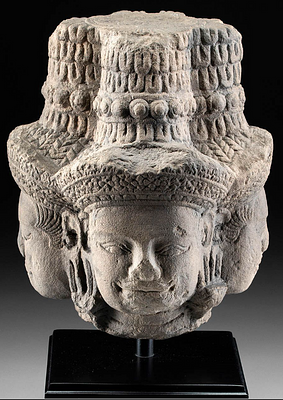Chinese Qi / Tang Stone Torso of Bodhisattva Guanyin
Lot 76a
About Seller
Artemis Gallery
686 S Taylor Ave, Ste 106
Louisville, CO 80027
United States
Selling antiquities, ancient and ethnographic art online since 1993, Artemis Gallery specializes in Classical Antiquities (Egyptian, Greek, Roman, Near Eastern), Asian, Pre-Columbian, African / Tribal / Oceanographic art. Our extensive inventory includes pottery, stone, metal, wood, glass and textil...Read more
Categories
Estimate:
$9,000 - $12,000
Absentee vs Live bid
Two ways to bid:
- Leave a max absentee bid and the platform will bid on your behalf up to your maximum bid during the live auction.
- Bid live during the auction and your bids will be submitted real-time to the auctioneer.
Bid Increments
| Price | Bid Increment |
|---|---|
| $0 | $25 |
| $300 | $50 |
| $1,000 | $100 |
| $2,000 | $250 |
| $5,000 | $500 |
| $10,000 | $1,000 |
| $20,000 | $2,500 |
| $50,000 | $5,000 |
| $100,000 | $10,000 |
| $200,000 | $20,000 |
About Auction
By Artemis Gallery
Jun 29, 2023
Set Reminder
2023-06-29 10:00:00
2023-06-29 10:00:00
America/New_York
Bidsquare
Bidsquare : Exceptional Antiquities, Ethnographic and Fine Art
https://www.bidsquare.com/auctions/artemis-gallery/exceptional-antiquities-ethnographic-and-fine-art-13031
Artemis Gallery info@artemisgallery.com
Artemis Gallery info@artemisgallery.com
- Lot Description
East Asia, China, Northern Qi to Tang Dynasty, ca. 549 to 650 CE. A beautiful gray stone sculpture depicting a standing torso of a Bodhisattva Avalokitesvara, or Guanyin. The upright figure dons a diaphanous skirt tied in front by a belt, its folds and stylization creating a dynamic sense of movement characteristic of sculpture influenced by Gupta-era Buddhist artistry (ca. 320 to 647 CE). The chest is adorned with beaded necklaces and a grand pectoral ornament in relief between rounded, sloped shoulders, and the neck features a series of folds to enhance its realism. Lapidary artisans in the preceding Northern Wei Dynasty (ca. 386 to 534 CE) were known to have been strongly influenced by Buddhist stylization, so much so that it carried over into the sculptural techniques of artists well into the early Tang Dynasty. Size: 22.5" H (57.2 cm)
In Buddhist belief, Bodhisattvas are among the most compassionate beings in the universe, devoting themselves to saving the suffering and helping others achieve enlightenment and Buddhahood. In Chinese art from this time period and earlier, they are depicted as less austere than Buddhas, with graceful postures and elegant garments, a nod to the riches of the Northwestern Chinese Silk Road. This piece is no exception.
Cf. The Minneapolis Institute of Art, accession number 2007.18
Please note that this piece is a dropship item, meaning that it will be shipping from the consignor's location. All information regarding condition, size, stone identification, and metal content have been provided by the consignor.
Provenance: East Coast collection, New York Gallery, NY; ex-East Anglian private collection acquired in Hong Kong in the early 1990s.
All items legal to buy/sell under U.S. Statute covering cultural patrimony Code 2600, CHAPTER 14, and are guaranteed to be as described or your money back.
A Certificate of Authenticity will accompany all winning bids.
We ship worldwide and handle all shipping in-house for your convenience.
#179937Losses as shown, else excellent.Condition
- Shipping Info
-
All shipping is handled in-house for your convenience. Your invoice from Artemis Gallery will include shipping calculation instructions. If in doubt, please inquire BEFORE bidding for estimated shipping costs for individual items.
-
- Buyer's Premium



 EUR
EUR CAD
CAD AUD
AUD GBP
GBP MXN
MXN HKD
HKD CNY
CNY MYR
MYR SEK
SEK SGD
SGD CHF
CHF THB
THB














